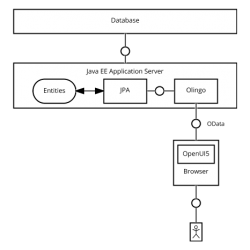This blog post will describe a killer Java EE architecture that connects the database through a JPA layer to the client.
The client will use OpenUI5 with a OData Model. I coded this whole project in around 2 hours on a sunday. The results are published on github:
https://github.com/ManuelB/blueprint
Application Code
Here is the amount of code that was needed:
$ find . -name "*.j*" | xargs wc -l| LOC | File |
|---|---|
| 34 | ./src/main/java/de/incentergy/architecture/JAXRSConfiguration.java |
| 92 | ./src/main/java/de/incentergy/architecture/JpaODataServiceFactory.java |
| 26 | ./src/main/java/de/incentergy/architecture/entities/Todo.java |
| 21 | ./src/main/webapp/blueprint/Component.js |
| 28 | ./src/main/webapp/blueprint/controller/TodoDetails.controller.js |
| 7 | ./src/main/webapp/blueprint/controller/App.controller.js |
| 21 | ./src/main/webapp/blueprint/controller/TodoList.controller.js |
| 229 total | |
Database
I am using the default relational database that comes with my application server. When using wildfly this will be the H2 database engine. There is currently a lot of hype for No SQL databases. My personal opinion is, that one of the best no sql databases is the Java Heap this means that a Java HashMap will have amazing performance. Most of NoSQL databases are not solving any new problems. Most of the time they are only invented for a single purpose e.g. Amazon Dynamo to save the Amazon Cart and Voldemort was used by LinkedInn to cache social content. If you do not have these special requirements there is no need to use a no sql database.
Application Server
Every application has to run on an application server. I prefer Wildfly 10 mainly because it has a fast innovation cycle and is the basis for a commercial product. Java EE application servers are known to be big and slow which is kind of true. Nevertheless there are a lot of people trying to make them work easily e.g. my demo application is based on a maven build. The maven build will automatically download the application server and start it. Every other solution for installing enterpise applications like docker, Java Web Start, .NET click once has a similar overhead and has the same complexity. So our application can be run with these simple commands:
git clone https://github.com/ManuelB/blueprint.git
cd blueprint
mvn wildfly:runPrequisits are: Git, Java 8, and Maven 3.3
Server-side-application a.k.a. Web Application
The application itself is a tuned Java EE version of Olingo exposed through a JAX RS endpoint. The transaction handling is done with a UserTransaction that is retrieved from JNDI. Currently Olingo does not have nice support yet for JTA or even better for CDI. It is necessary to use JNDI to get the correct objects that are needed.
Client-side-application a.k.a. HTML5 OpenUI5 GUI
The client side is implemented as an OpenUI5 component containing 5 views and 3 controllers. These are connected through the ODataModel that is exposed the global model and it can be used everywhere to bind server values to view.
Conclusion
The given architecture is state of the art. If you want to learn more about these technologies ask you boss to book one of our classes.

Leave a Reply to Sergey Batsura Cancel reply